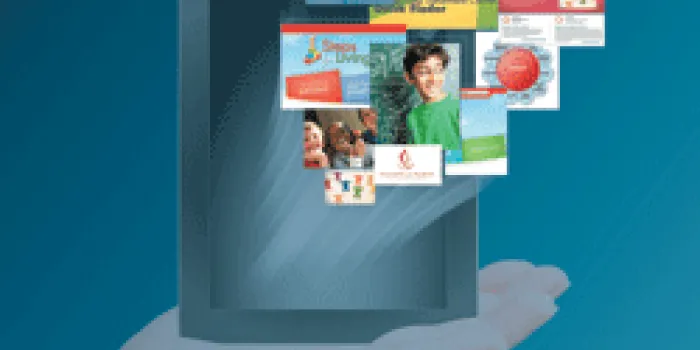Being diagnosed with a bleeding disorder can spark a lifetime of questions. As treatments, research, medical protocols and healthcare policy evolve, many members of the bleeding disorders community find themselves glued to a computer screen, clacking away at the keyboard looking for answers.
The National Hemophilia Foundation (NHF) and other partners in the bleeding disorders community have expanded online education efforts to meet members of the bleeding disorders community where they are—on the Web. “Because people are accessing information that way, we are making sure NHF has a voice,” says Ayana Woods, NHF’s director of education.
NHF has developed several online learning resources for various groups within the bleeding disorders community—patients and families, healthcare advocates, hemophilia treatment center (HTC) clinicians and people indirectly touched by bleeding disorders, including school teachers and significant others. Offering online education starts with tapping into what brings these audiences to the Web and delivering the information they want with just a few clicks.
Online Education for Life
Managing life with a bleeding disorder means adjusting to changes during different stages of development, from childhood and adolescence through adulthood and into the mid-life and senior years. That’s why NHF launched Steps for Living, an interactive Web site. “It’s a toolkit to help families and children deal with daily challenges of living with a bleeding disorder, which can include everything from school issues and exercising safely to dating and attending college,” says Woods, who manages the site’s content.
The Steps for Living Web site is an expansion of NHF’s First Step program, developed through a partnership with the US Centers for Disease Control and Prevention (CDC). First Step enabled new families to learn more about their child’s diagnosis, interact with others in similar situations and receive advice from veteran parents in their local community. Its successor, Steps for Living, was developed in partnership with the CDC and in collaboration with Pfizer Hemophilia.
 The first component of Steps for Living went live in May 2011 with the “First Step” section, for parents of affected children from newborn to age 8. The “Next Step” section, for those ages 9 to 15, launched in November 2011, and the “Stepping Out” section for 16 to 25 year olds launched a month later. The site also includes a special section, “What Everybody Should Know.” It dispels myths around bleeding disorders, and provides facts related to successful treatment and management.
The first component of Steps for Living went live in May 2011 with the “First Step” section, for parents of affected children from newborn to age 8. The “Next Step” section, for those ages 9 to 15, launched in November 2011, and the “Stepping Out” section for 16 to 25 year olds launched a month later. The site also includes a special section, “What Everybody Should Know.” It dispels myths around bleeding disorders, and provides facts related to successful treatment and management.
Using quizzes and other interactive tools, each section of the Steps for Living site covers the basics of living with a bleeding disorder at certain stages of life, such as symptoms, treatments, family relationships and maintaining a healthy body. It is written so that even a child can walk away more knowledgeable. “We want to empower youth to start making decisions, independently managing their disorder and expressing their medical needs if they are away from family,” Woods explains.
So far, the results have indicated that the site is meeting a real need. Between January and June 2012, the Steps for Living site had more than 10,000 visitors, more than 79% of whom were new to the site. More than 85% were referred from another site, mainly search engines, such as Google or Bing. The next section to be posted, “Step Out,” will cover topics for people age 26 and older, such as financial planning, relationships and marriage, and psychosocial issues. In the near future, Steps for Living will include a variety of videos and other interactive elements, Woods says.
Online Education For Women
NHF has also launched a Web site for a group whose specific bleeding disorder concerns are often marginalized—girls and women. VictoryForWomen.org is designed to bring women’s concerns to the forefront.
Launched in July 2012, the site targets women who have been diagnosed or who are symptomatic but have not yet sought care. It also provides information for their clinicians. Diagnosed women can find resources to help them navigate current and future changes they’ll experience at various ages, from puberty to menopause. The section of the site for undiagnosed women helps them make sense of frequent bruising, challenging menstrual cycles or spontaneous nosebleeds—symptoms they may not recognize as resulting from a bleeding disorder. Healthcare providers can also find the latest information on treatments and recommendations for their female patients.
“The validation for women with bleeding disorders is so important,” says Patrice Thomas, MS, MSW, manager of education at NHF and coordinator of the Victory for Women program. “Many of them have dealt with healthcare providers who tell them their symptoms are not severe and don’t take them seriously.” This includes women whose experiences have been dismissed because of the myth that women cannot have bleeding disorders.
The site’s content was developed with input from a working group of NHF’s Victory for Women task force. The group included a physician, nurse, health educator and women who have bleeding disorders. Some of the content is cross-linked to existing content on hemophilia.org, while other content was inspired by local chapters and NHF’s Annual Meeting sessions.
“We wanted a site that is inviting to all girls and women, no matter what their age or condition,” Thomas says. “We hope when women land there, they’ll say, ‘I’m so happy to have found this site. This is what I’m struggling with,’ and feel validated.”
Keeping Up With Healthcare Policy
Life transitions are not the only factors that drive people to the Web for information. Sweeping policy changes, namely the federal Affordable Care Act signed into law in March 2010, also prompted NHF to bolster online education efforts.
The American Plasma Users Coalition (A-PLUS), a group of national patient advocacy organizations that includes NHF, addresses the unique needs of patients with rare diseases who use plasma protein therapies. In 2011, A-PLUS collaborated with Georgetown University’s Health Policy Institute to create the State Exchange Project. NHF serves as both the fiscal agent and project manager of the program. One component of the project is a four-part webinar series that educates chapter leaders and state policy advocates. The first in the series, titled Essential Health Benefits: What State Advocates Need to Know, was held in March 2012, followed by the second in May, State Exchange Update. The goal is to make sure the healthcare needs of those with rare diseases, including bleeding disorders, are considered as healthcare reform is implemented in each state.
More than 140 advocates participated in the first two webinars. The remaining two webinars will address other key aspects of implementation, such as federally facilitated exchanges and Medicaid expansion. “Webinars are an effective way to inform large numbers of advocates from diverse locations and groups,” says Michelle Rice, NHF’s director of public policy. “The project’s main goal is to assist advocates in their state advocacy efforts by providing strategic guidance and helping to craft a unified message. We are saying, ‘The health reform implementation process is complex with many moving parts. Here is where advocates need to focus their attention.’
“Collaborating with others and presenting a shared, common message help to raise our voices above the noise and ensure that the needs of those we serve are not lost in the process,” Rice adds.
The webinar series, available on the NHF Web site, provides the chapters with a cost-effective method of sharing the information with their local community. “Gas prices are high and the economy is down, so it’s hard to travel,” Rice explains. “Webinars are flexible enough that if someone has a schedule conflict, they can watch the program later. They also give us a more expanded audience and the ability to distribute more timely information.”
The healthcare reform series comes on the heels of a previous webinar series, offered in partnership with the Specialty Healthcare Benefits Council and MedSpan, titled Managed Care and Hemophilia—Opportunities for Most Cost Effective Care. This series provided education for managed care payers, many of whom are new to the bleeding disorders community, about bleeding disorders and standards of care, as well as explore opportunities for them to collaborate with HTCs to achieve cost-effective, quality care. The series ran from 2010 through 2012, and consisted of six webinars per year, conducted by a team of HTC physicians, nurses and managed care executives.
Attendance has increased each year, beginning with 66 participants in 2010 and more than 200 in 2012. To date, more than 400 managed care and pharmacy executives have participated, Rice says. Because participants have indicated a need and desire for more information about bleeding disorders, NHF is hoping to continue its payer education efforts into 2013 and beyond.
Courses for Clinicians
Staying updated is also important for clinicians who treat patients with bleeding disorders. Treatments advance, and research is constantly confirming or changing the clinical understanding of bleeding disorders, prompting even the most seasoned care providers to go back for a refresher course. To help clinicians stay current, NHF teamed up with the Indiana Hemophilia & Thrombosis Center (IHTC) in Indianapolis and the Hemophilia Foundation of Michigan to bring clinical education to the Web through the Partners PRN program.
Since Partners PRN was launched in 2009, nearly 30 modules have been created, touching on everything from basic primers to intricate topics, like inhibitors and danger signals. The closed-access modules are open only to physicians and nurses at HTCs with a username and password. Another set of open-access modules for any medical care provider who wants to learn more about bleeding disorders became available in December 2011.
Partners PRN is a branch of the Partners in Bleeding Disorders Education, a series of two-day, in-person classes that started in 1996. “The in-person educational offerings are fairly structured,” says Amy Shapiro, MD, co-medical director and pediatric hematologist at the IHTC. “We wanted—and the participants wanted—a system that was more flexible, that was geared toward a multidisciplinary team and that was timely.” Funding to support the Partners in Bleeding Disorders Education program is provided through an unrestricted educational grant from Baxter HealthCare.
The Partners PRN online modules blend video game animation with the substance of a textbook. Each module goes through a rigorous development process that can take up to one year. A national advisory board of physicians and nurses identifies topics. Content is written by national and international experts, reviewed by advisory board members and finalized by Partners staff at the IHTC. All modules available on the closed-access site are provided in collaboration with the University of Nebraska Medical Center, College of Nursing Continuing Nursing Education in Omaha and accredited for continuing nursing education credits. The university is accredited as a provider of continuing nursing education by the American Nurses Credentialing Center’s Commission on Accreditation.
“Different people learn in different ways,” says Natalie Duncan, MPH, Partners program coordinator at IHTC. “People can stop and start as they need to. The evaluation responses are overwhelmingly good.”
So far, the Partners PRN closed-access modules have attracted more than 685 registered users, primarily HTC staff. More than 150 users have registered for the open-access site. Those numbers are expected to increase as more modules are added, including information for dentists, pharmacists, social workers and physical therapists.
NHF plans to expand its online education. Its overarching goal is to empower people within the bleeding disorders community with information when they need it most. That way they’ll have their questions answered, sometimes through a simple click of a mouse.

